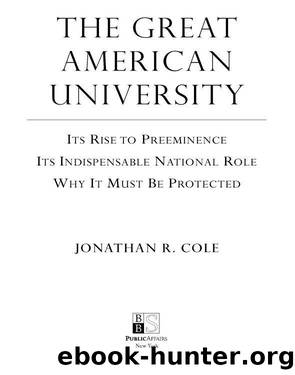The Great American University by Jonathan R Cole

Author:Jonathan R Cole
Language: eng
Format: epub
Publisher: PublicAffairs
Social Structures and Social Networks. Each of the social and behavioral sciences has its own unique angle of vision on behavioral patterns. Psychologists see psychological causes behind the same pattern of behavior that sociologists see as a result of social structural forces. In fact, for decades, sociologists and anthropologists searched for structural theories of behavior in an effort to differentiate their explanations from those that were fundamentally social psychological.
Structural analysis goes back a long wayâit was adopted as a mode of explanation by the great anthropologists of the early twentieth century and revived by Harvard sociologist Talcott Parsons, who tried to construct a theoretical basis for the analysis of social structures in the 1950s. In more recent years, the discoveries of structuralism have been augmented and extended in a new line of theory and research called ânetwork analysis.â One of the leading figures in this area has been Harrison C. White, who taught at Carnegie Mellon University, the University of Chicago, and Harvard before moving to the University of Arizona and then Columbia University. White was trained as a physicist, and his mathematical models led the way in developing network theory and analysis. The signature ingredient of his work, and of the work by the extraordinary number of talented students whom he trained, has been his focus on social structures based on patterns of relationships rather than on attributes of individuals. In the first decade of the twenty-first century, social network analysis is perhaps the principal way of examining social structures and organizations in sociology.
If Harrison White is the putative father of ânetwork analysis,â his disciples have done him proud. Mark Granovetter, who received his Ph.D. at Harvard and studied with White, and has taught at the State University of New York at Stony Brook as well as at Stanford, used network analysis to demonstrate that people were more apt to find jobs through acquaintances than through close friends. His paper âThe Strength of Weak Tiesâ (1973) was one of the most influential pieces of work in network theory. He demonstrated that in marketing and politics, the use of acquaintances (âweak tiesâ) enables people to reach audiences that would not be accessible through the use of close friends (âstrong tiesâ). He compares information flow where there is a low-density network (where many lines indicating direct relationships are absent) with information flow in a high-density network (where most of the possible lines among friends are present).
Granovetter wrote that âthe weak ties between Ego and his acquaintanceâ were âa crucial bridge between the two densely knit clumps of close friends,â pointing out that âthese clumps would not, in fact, be connected to one another at all were it not for the existence of weak ties.â People without weak ties, he concluded, âwill be deprived of information from distant parts of the social system and will be confined to the provincial news and views of their close friends.â19 Weak ties lead to more rapid innovations, to an increased ability to coordinate efforts, and to greater access to resourcesâand in the case of the labor market, to greater job opportunities.
Download
This site does not store any files on its server. We only index and link to content provided by other sites. Please contact the content providers to delete copyright contents if any and email us, we'll remove relevant links or contents immediately.
| Administration | Assessment |
| Educational Psychology | Experimental Methods |
| History | Language Experience Approach |
| Philosophy & Social Aspects | Reform & Policy |
| Research |
The Art of Coaching Workbook by Elena Aguilar(50984)
Trainspotting by Irvine Welsh(21518)
Twilight of the Idols With the Antichrist and Ecce Homo by Friedrich Nietzsche(18503)
Fangirl by Rainbow Rowell(9095)
Periodization Training for Sports by Tudor Bompa(8170)
Change Your Questions, Change Your Life by Marilee Adams(7635)
This Is How You Lose Her by Junot Diaz(6794)
Asking the Right Questions: A Guide to Critical Thinking by M. Neil Browne & Stuart M. Keeley(5632)
Grit by Angela Duckworth(5523)
Red Sparrow by Jason Matthews(5390)
Paper Towns by Green John(5089)
Room 212 by Kate Stewart(5035)
Ken Follett - World without end by Ken Follett(4645)
Housekeeping by Marilynne Robinson(4345)
The Sports Rules Book by Human Kinetics(4294)
Double Down (Diary of a Wimpy Kid Book 11) by Jeff Kinney(4207)
Papillon (English) by Henri Charrière(4195)
The Motorcycle Diaries by Ernesto Che Guevara(4012)
Exercise Technique Manual for Resistance Training by National Strength & Conditioning Association(3955)
